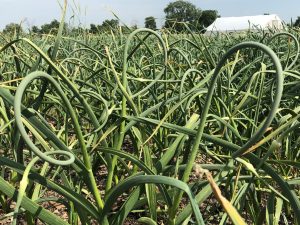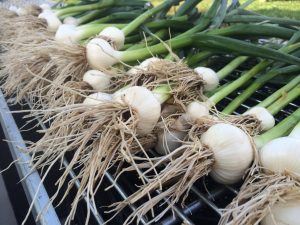The Many Stages of Garlic

This is what garlic looks like in the field.
Have you been stumped by all the garlic products coming your way? Green garlic, garlic scapes, now “fresh” garlic… How are they different? And when do you get the “normal” dried garlic that you’re used to?
Before I married a farmer, I had no idea there were so many versions of garlic. I just knew about the little bulbs from Kroger.
Now that I’ve had ‘real’ locally grown garlic, there is simply no comparison. Farmer Kurt’s are bigger, tastier, and spicier. Plus, our soil seems to really like growing garlic — not all farmers have as much luck as we do.
And even better, as it turns out, just about every stage of the garlic plant is edible — each with its own flavor profile, so it’s fun to experiment in the kitchen.
Garlic is planted around Halloween each year so it can overwinter. In the spring, little green sprouts emerge from the soil and begin to grow. We harvest its various stages all the way through July, when it is finally “done” and removed from the field to cure.
Do the math, and that’s 9 months out of the year that garlic is “taking up” precious real estate in our soil. There’s a good reason we charge a premium price for our garlic.

This is green garlic.
Green Garlic
In May, we can harvest some of these plants, by pulling the whole thing out of the ground. This is called the “green garlic” stage, and it looks a lot like a green onion at this point. The green stalks are flat like leeks, and the bulb is white with a twinge of pink.
Garlic scape
About 3 weeks later, the plant begins to form the flower — called a scape. The scape looks like a curlicue, and if left alone, will straighten and bloom into a beautiful white round puff-ball type flower. (Remember: plants have one purpose in life too — to reproduce). But because we want the plant to use its energy to grow a bigger garlic bulb underneath, we have to remove the scape.

See the curlicue? That’s the scape.
FUN FACT: We always leave a few scapes uncut as “indicator plants.” When the scape straighten and flowers, we know that the scaped garlic is ready to harvest.
We cut the scapes off each plant by hand (thousands of them) and bundle them into bunches of 5-6. You get these in your CSA box for a few weeks in late June. You can use every part of the scape — even the leathery tip that eventually would form a flower. Simply chop it up and use in place of garlic. If you start getting overwhelmed by garlic products from the farm, chop them up and freeze them. You’ll be glad you did, when you can have farm garlic into the winter months. I also like to make garlic scape compound butter, or pesto.

Fresh garlic has bright white skins and must be refrigerated.
Fresh garlic
In mid to late June, after the scapes are removed, we can begin to harvest premature garlic bulbs fresh from the ground. They will be on the smaller side but they have a great garlic flavor too. Because these are straight from the field (and not cured), they must be refrigerated, and they must be eaten within 7-10 days before they begin to go bad. The skins will be a bright white and thicker, and the garlic itself will seem juicier and crisp. You can chop and freeze fresh garlic as well if you can’t get through it fast enough.
Cured garlic

Cured garlic has papery think skins, and should be stored in a cool, dark, dry place.
In mid-July, we begin to harvest all the remaining garlic plants from the field to cure them. We simply pull the entire plant from the soil, shake off the soil attached to the roots, and then lay them on ventilated racks for about 7-14 days in the barn to “cure.” (That basically means dry out). Once cured, the garlic will have a long shelf life. We then cut off the roots and stem and grade them by size.
Garlic seed

Each garlic clove is “shucked” — separated from the bulb — and becomes our seed for next year.
We save the biggest and best of the cured garlic for seed. In September, we “shuck” the cloves from the garlic bulbs. Each clove is a seed for a future garlic plant. You could in theory take one of our garlic bulbs and save it for seed yourself! (If you can stand not eating it). Plant the clove pointy-side up in October in well-mulched soil, and watch it emerge next spring. Don’t try this with the cheap garlic stuff from the grocery store. You want high quality seed stock.
